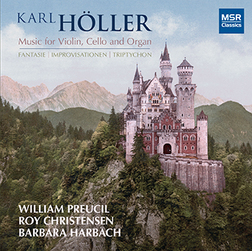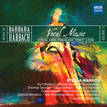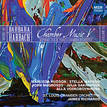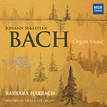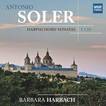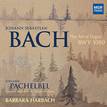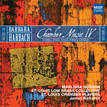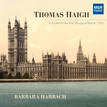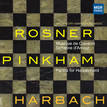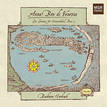KARL HÖLLER
Music for Violin, Cello and Organ
Karl Höller
BARBARA HARBACH, organWILLIAM PREUCIL, violin
ROY CHRISTENSEN, cello
Digitally Remastered
[
MS1445]
$14.95
LISTEN
REVIEWS
“These pieces are colorful, polyphonic, and beautifully crafted, employing a tonal idiom redolent of Hindemith and Reger, with a hint of the 20th Century French school. The combination of organ and strings works very well, and the recorded balance is excellent. Precuil and Christiansen are fine players, and Harbach offers excellent accompaniments”
Delcamp, American Record Guide [May/June 2017]
“Barbara Harbach, a very fine organist as well as a skilled composer in her own right, clearly finds the music of Höller congenial... Höller’s integration of the stringed and wind instruments is so well done that listeners may wonder why the combination is so rare.”
Mark J. Estren, InfoDad [April 2017]
“[Höller’s] Fantasie for Violin and Organ begins with an extended violin solo, effectively showcasing Preucil’s incomparable artistry... Of course, the superlative artistry of Preucil and Harbach could make the phone book sound like a masterpiece, were it somehow transcribed to musical pitches... Höller’s Tryptichon for solo organ forms the centerpiece of this recital. Here, Harbach is allowed to pull out all the stops, and the opening almost knocks the listener out of his chair. The M. P. Moller organ found in the First Church of Christ Scientist in Buffalo, NY, is an impressive [instrument]
I found [Höller’s Improvisations] very satisfying... Not many composers have written for the combination of cello and organ, but the combination works exceedingly well, and Roy Christiansen’s consummate artistry is on full display throughout the 23-minute suite... I find no fault in any aspect of [this disc's] production... I consider Höller’s music elegant and profound, and the performances it receives here simply cannot be surpassed.”
David DeBoor Canfield, Fanfare [May/June 2017]
“[the Fantasie, Improvisations and Triptychon] show Höller’s main characteristics: late Romantic tonal language with elements of the mature Hindemith’s neo-classicism and an interest in baroque forms and structures. The recording quality handles the combination of string instrument and organ with such balance and clarity that it makes you woder why more composers don’t try this interesting genre.”
Records International [January 2017]
[ * * * * / 4 Stars] “[Christensen’s instrument] sports a lovely, burnished tone.”
Gary Lemco, Audiophile Audition [January 2017]
PROGRAM NOTES
Karl Höller was born on 25 July 1907 in Bamberg, one of the most beautiful medieval towns in Germany. He embodied the fourth generation of a family of gifted musicians. His grandfather, Georg Höller, son of the organist Peter Höller, was the focal point of musical life in Würzburg. Georg Höller’s daughter, Gretchen, was a gifted composer who succeeded her father as the organist of the Würzburg cathedral; she was one of the first female professional organists of the time. Her three sisters pursued the same careers. Höller’s father, Valentin, was organist at the cathedral of Bamberg, and his mother, Anna Margaretha Drausnick, was the daughter of the director of the Bamberg Oratory Choir and an accomplished musician herself. Karl Höller’s parents lived in a medieval complex of buildings close to the cathedral, whose mighty spires tower above everything, drawing people’s eyes upward. The droning peals of the huge bronze bells penetrated even the thickest walls and the ancient oak floors carry the vibrations to the furthest chamber. Thus, Karl Höller was born into a world of music.
At the age of six, Höller became a choir boy and at eight he began to substitute for his father at the cathedral’s huge organ. After college, he studied under Herrmann Zilcher in Würzburg and then continued his studies in Munich where Joseph Haas was his mentor. In 1937, he accepted an offer to teach at the Frankfurt Music Academy. During World War II, he was lucky enough not to be drafted, though he escaped by a hair’s breadth. Höller withdrew from the terrible war-time reality into the world of music. In the midst of hunger, despair and air raids, he composed one masterpiece after another. To Höller, it was nothing short of a miracle that he survived that apocalypse, weakened, but relatively unharmed. In the last days of the war, Höller had taken refuge in Bamberg. There, on New Year’s Eve in 1944, he gave the last concert before capitulation – an organ concert in St. Michael’s Cathedral. Then again, on the 21st of July 1945, he performed in the first post-war concert in the Bamberg cathedral – the United States government even lifted the curfew for the event.In 1949, Höller accepted an offer to teach at the Munich Music Academy, which was nearly destroyed during the war. In 1954, he became president of that institution, turning it into one of Europe’s finest music academies in a surprisingly short amount of time. Höller was the head of the Academy for 18 years, and during this time built up contacts all over the world. He arranged exchange concerts and participated on the Jury of numerous music competitions, including the Queen Elisabeth Competition in Belgium and the Long-Thibaut Competition in Paris.
Also an outstanding conductor, Höller sought to conduct as many of his orchestral works as possible. However, his ever-increasing responsibilities at the Academy and throughout the music scene-at-large soon made conducting impossible. He therefore concentrated on his most fundamental talent, composing, and created a large and distinguished oeuvre of which his organ works are particularly notable. Höller was an undisputed master of the great instrument, having loved it all his life. Owing to his heritage and lifelong involvement with the old masters of counterpoint, Höller’s work is modern in the best sense: adventuresome, but always rooted in tradition.
Violinist
William Preucil has appeared regularly as a soloist with The Cleveland Orchestra in concerto performances at both Severance Hall and the annual Blossom Music Festival. Prior to joining The Cleveland Orchestra, of which he became concertmaster in 1995, Preucil served as first violinist of the Cleveland Quartet, performing in the world’s major music capitals. From 1982 to 1989, he was concertmaster of the Atlanta Symphony, after having held the same position with the orchestras of Utah and Nashville. Preucil has also made solo appearances with the symphony orchestras of Detroit, Minnesota and Rochester and in Hong Kong and Taiwan. Preucil regularly performs chamber music, often in the festival setting, including in Santa Fe, Sarasota and Seattle, and internationally in France, Germany and Switzerland. During the summer, he serves as concertmaster with the Mainly Mozart Festival Orchestra in San Diego. Preucil also performs as a member of the Lanier Trio. An active educator, Preucil is the Distinguished Professor of Violin at the Cleveland Institute and Furman University, and has taught at the Eastman School and University of Georgia. He studied with Zino Francescatti, György Sebök and Josef Gingold at Indiana University, where he was awarded a performer’s certificate.
Cellist
Roy Christensen began an orchestral career as assistant principal of the Milwaukee Symphony at the age of 16. He went on to become principal cellist of the Atlanta Symphony Orchestra, and at age 22 began a 10-year tenure as principal cellist of the Cincinnati Symphony Orchestra. He also served for a time as the principal cellist of the Springfield Symphony Orchestra in Massachusetts. Christensen was also active as a recording artist, releasing a number of solo and chamber music recordings. Later in his career, he was highly active as a recording producer and engineer.
Barbara Harbach has toured extensively as both concert organist and harpsichordist throughout the United States and Canada, and internationally in Bosnia, Croatia, Czech Republic, Germany, Hungary, Japan, Korea, Romania, Serbia and Siberia. Harbach’s lively performances and recordings have captured the imagination of many American composers, and the body of work written for and dedicated to her is substantial. She is involved in the research, editing, publication and recording of manuscripts of 18th century keyboard composers, as well as of historical and contemporary women composers. As an accomplished and prolific composer herself, Harbach has a large catalog of works, including symphonies, operas and ballets; works for chamber and string ensemble; musicals and film scores; works for organ, harpsichord and piano; choral anthems; and arrangements for brass and organ of Baroque music. Currently Curators’ Distinguished Professor of music at UMSL, Harbach holds a Bachelor degree from Pennsylvania State University, Masters degree from Yale, Konzertdiplom from the Musikhochschule-Frankfurt and a Doctorate from the Eastman School of Music. In 2002, she was awarded Honoris Causa from Wilmington College for her lifetime achievement as a composer, performer, editor and publisher.
M.P. MÖLLER ORGAN, OP.1500 [1913]
First Church of Christ Scientist | Buffalo, New York
The original organ for the First Church of Christ Scientist was built in 1913 by M.P. Möller, Op.1500, at a cost of $10,100. It had three manuals, five divisions, 36 stops, 43 registers, 36 ranks and 1,935 pipes. The manual compass was 61 notes with the pedal compass 32 notes. In 1956, Möller rebuilt the organ, Op. R-570, adding a new console, re-voiced reeds and six new ranks. The organ currently has four manuals, with the echo division located at the opposite end of the church.
PROGRAM
KARL HÖLLER (1907-1987)
FANTASIE for violin and organ, Op.49
TRIPTYCHON for organ solo, Op.64
On the Easter sequence “Victimae paschali laudes”
I. Improvisation “Amen”
II. Ricercar “Dic nobis, Maria”
III. Postludium “Amen. Alleluja”
IMPROVISATIONEN for cello and organ, Op.55
On the spiritual folksong “Schönster Herr Jesus”
I. Ruhig beginnen, frei deklamierend
II. Sehr lebhaft, schattenhaft
III. Gesangvoll fliessend
IV. Lebhaft und markiert
V. In ruhiger, ausdrucksvoller Bewegung
MSR Classics
